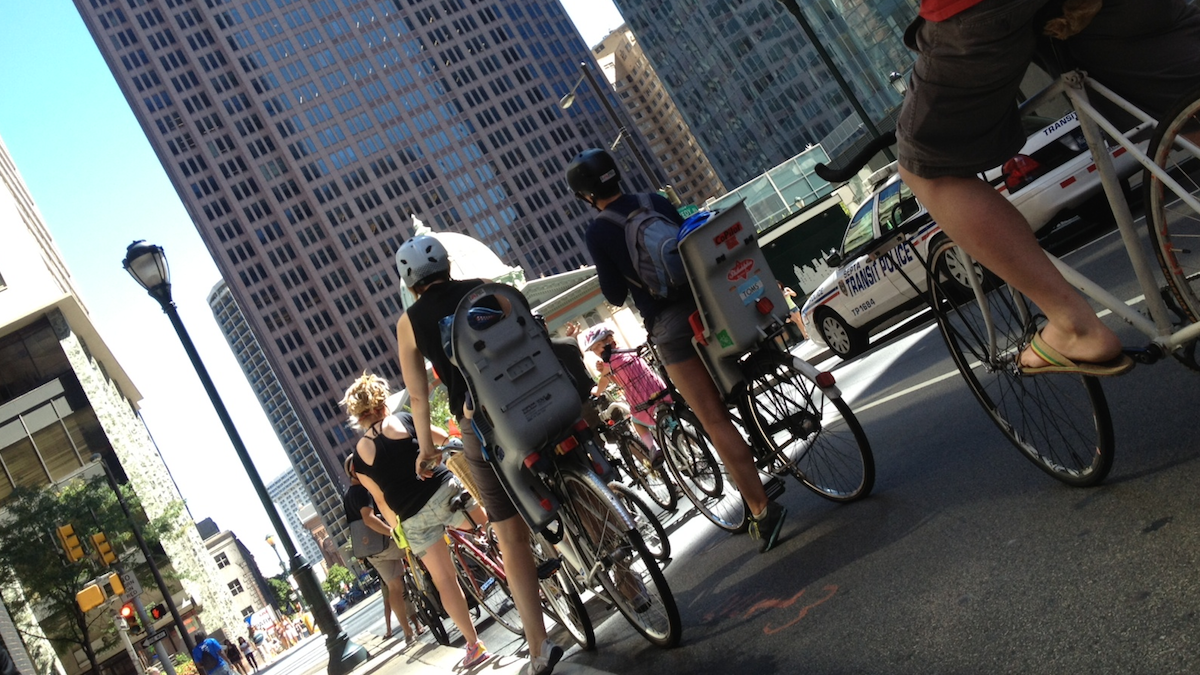Professor gathers infrastructure solutions from U.S. cities

People bike together through Philadelphia. (Dena Driscoll/for NewsWorks)
She says they’re using tech and finding funding in creative ways.
For decades, the American Dream has been synonymous with a car and a house with a white picket fence. But Rosabeth Moss Kanter imagines a day when people will dream of a high-rise apartment overlooking a park, instead.
Moss Kanter is a professor at Harvard Business School and she’s the author of Move: How to Rebuild and Reinvent America’s Infrastructure. Moss Kanter spent nearly two years visiting cities around the United States to see how they’re reimagining their infrastructure. In the book, she writes about some of those projects and advocates for walkable, bikeable cities — which, in the urban planning world, is called smart growth.
We spoke with Moss Kanter about some of the ways cities can start to reimagine themselves as places catering to not just cars, but also to pedestrians and bikers. Here are some take-aways:
On using technology to reimagine a city’s streets
Moss Kanter acknowledges that some infrastructure changes — like building a new light rail system or even subway stop — take a long time. “But it doesn’t take very much time to get people a lot more information through their smartphones,” she countered. And cities can do that using technology that already exists. As an example, she suggests that cities create apps that allow riders to buy tickets online and then show barcodes to conductors on their smartphones, rather than buying printed tickets at machines.
Cities can also enable their citizens to collect data about how infrastructure is holding up. Boston, for instance, offers an app called “Street Bump” that senses potholes and other road imperfections during a user’s car ride and sends that data to the city.
In some cities, companies that offer ride-sharing are changing the way people get around. Bridj, for instance, is an on-demand, private urban bus service that operates in the Boston area. The buses are air-conditioned, with leather seats, and they offer a faster ride to the city’s downtown. Users check in on tablets when they board. Proponents says Bridj and similar services are a way for the private sector to fill gaps in bus service.
But even though Bridj is cheaper than a cab, it still costs more than many people can afford every day. A member of Moss Kanter’s research team rode the service from Brookline, Massachusetts to downtown Boston. On Bridj, the ride cost $5 to $8. A cab would have been about $15. But taking the subway would have cost $2.50.
Technology can also help cities manage traffic, Moss Kanter writes, suggesting that cities install sensors underneath streets that can control traffic lights and spot emergencies. “All of that keeps us moving, and mobility is opportunity,” Moss Kanter said. “If we can’t move, we can’t work, we can’t get home to have dinner with our family, and we don’t have opportunity.”
On how cities in Pennsylvania can begin to create streets that are approachable for people who are walking
There are some Pennsylvania cities that simply aren’t designed for pedestrians or bikers — cities where there are few sidewalks, and you need a car to get around. How can you make those places walkable?
Moss Kanter says it’s about starting people in the habit of walking. First off, build housing developments in the city center, and attract developers who will build mixed-use buildings, where apartments, offices, and stores are within walking distance. Then, she says, a city will have a constituency for paths and parks.
On how cities can find the money to reinvent their infrastructure
In 2012, Chicago had an unfunded pension liability of $19.5 billion, a struggling public school system, and a long list of other problems, Moss Kanter writes in Move.
And yet, in 2012, the city released a $7 billion plan to repair and reinvent its infrastructure. The plan — which included building new bus rapid transit routes and subway stations, retrofitting city buildings to reduce energy consumption, and rebuilding 900 miles of water pipes — was funded largely by making the city more efficient, tacking on new water fees, tapping into new sources of revenue, like licensing billboards on city land along highways, and creating a municipal infrastructure trust, a pool of money dedicated to infrastructure projects, which experts choose based on their merits.
As the Urban Land Institute describes, the trust’s mission is “to devise and orchestrate projects to help give the city’s aging transportation system, public buildings, and energy production a badly needed upgrade, and to repurpose vacant or underused properties to promote economic development and improve the city’s tax base.” The trust pays for those changes with private sector dollars, and it attracts those investors “by finding ways to structure deals so [they] can realize a return, even as the public benefits from the investment.”
And although tax hikes tend to be unpopular, Moss Kanter says they can get support, if they’re funding the right initiative. “Citizens will often vote for an increment in the sales tax, a small increment, if it will get them out of traffic congestion,” she said. “I’ve seen that in many cities around the country.”
WHYY is your source for fact-based, in-depth journalism and information. As a nonprofit organization, we rely on financial support from readers like you. Please give today.


